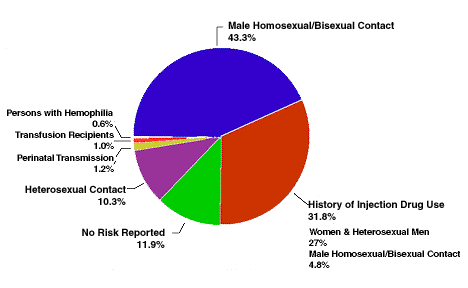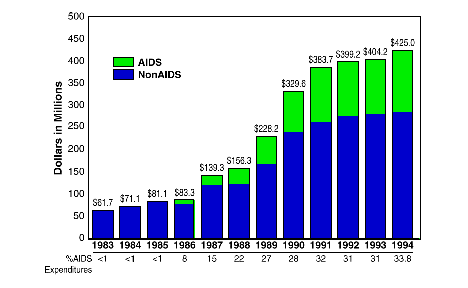Since AIDS was first identified in 1981, the disease has brought death and widespread physical and social devastation to people and nations worldwide. An estimated 1 million Americans today are infected with HIV, the human immunodeficiency virus, which causes AIDS; as many as 17 million people are infected worldwide. According to the Centers for Disease Control and Prevention (CDC), 441,528 cases of full-blown AIDS were reported in this country through the end of 1994. Of these, approximately 60 percent have died.
 Injection drug use was the second leading cause of new AIDS cases through mid-1994.
Injection drug use was the second leading cause of new AIDS cases through mid-1994.HIV infection is now the leading cause of death among Americans ages 25 to 44, according to the CDC. The transmission of HIV from women to their newborn infants is also a growing problem.
The critical connection between drugs and AIDS has become increasingly evident. Injection drug use was the second leading cause of new AIDS cases through mid-1994, accounting for 31.8 percent of all cases, according to the CDC (see chart below).
One analysis based on current CDC data concluded that more than half of the 40,388 new HIV infections in 1994 were drug related. Groups at extremely high risk of infection include injecting drug users who share needles and other drug-use paraphernalia as well as crack addicts who engage in unprotected sex with multiple partners. Also at high risk are sexual partners and offspring of these drug abusers.
Because of this crucial link between AIDS and drug abuse, NIDA has played a critical role in the Government's strategy to control the spread of AIDS since early in the epidemic. Today, with a budget of $147 million for AIDS-related research, NIDA is the third largest supporter of AIDS research among the 17 Institutes of the National Institutes of Health. One-third of NIDA's research funding is committed to studying AIDS.
 Reported U.S. AIDS Cases by HIV-Exposure Category - 1994. Source: Centers for Disease Control and Prevention,Morbidity and Mortality Weekly Report, Vol 44, No. 4, Feb 3, 1995
Reported U.S. AIDS Cases by HIV-Exposure Category - 1994. Source: Centers for Disease Control and Prevention,Morbidity and Mortality Weekly Report, Vol 44, No. 4, Feb 3, 1995For its AIDS research agenda into the 1990s, NIDA has taken its lead from the 1988 Charlottesville, Virginia, conference of the Public Health Service's leading AIDS experts, who coordinated a major public health response to the epidemic. The Charlottesville meeting set a number of public health goals relating to the drug abuse population: increasing the number of drug abuse treatment slots for injecting drug users; improving the quality and effectiveness of drug abuse treatment; recruiting and training drug abuse treatment specialists; increasing outreach and education efforts for injecting drug users and their sexual partners; and conducting research to clarify the extent, nature, and natural history of injection drug use and needle sharing, with special attention to cultural and ethnic differences in drug-related practices and behavior.
To advance those goals, NIDA has supported a broad agenda of research into AIDS-related drug-use behaviors and HIV risk-reduction interventions. Central to these efforts have been studies to improve drug abuse treatment and outreach strategies to reduce injecting drug use and related risk behaviors. Other NIDA studies have monitored the natural history and epidemiology of HIV and AIDS; explored basic research areas such as immunology and neuropharmacology; examined the needs of special populations such as women, children, and racial and ethnic minorities; and enhanced medical care and services to improve the lives of those who are HIV infected.
 NIDA's AIDS and NonAIDS Expenditures. Source: NIDA Budget Office
NIDA's AIDS and NonAIDS Expenditures. Source: NIDA Budget OfficeNIDA's research findings have resulted in major advances toward curtailing the spread of AIDS. Research has shown that comprehensive drug abuse treatment programs can be effective in reducing high-risk HIV behaviors. For addicts not in treatment, community-based street outreach (prevention and intervention) programs have been effective in recruiting hard-to-reach crack smokers and injecting drug users and in educating and motivating them to change high-risk drug-use practices and sexual behaviors. Basic and clinical research has provided vital information on the origin and development of drug-related HIV and AIDS.
The challenge for NIDA now is to build on the advances already gained, fostering further research to unravel the intricate secrets of AIDS and designing improved interventions to bring this epidemic under control. To meet this challenge, NIDA in 1993 adopted a 5-year strategic plan for AIDS research to learn more about reducing the transmission of HIV among drug users, their sexual partners, and their children. The plan has six elements:
- to conduct research to improve existing treatment approaches and develop pharmacologic and nonpharmacologic therapies;
- to carry out research to improve educational and behavioral strategies, including studies on outreach approaches, prevention and early diagnosis, and treatment of drug abuse;
- to undertake natural history studies of drug abusers, studies of drugs as potential cofactors in HIV disease, and basic and clinical immunological studies;
- to conduct seroepidemiological studies of drug abusers, studies of the nature and extent of at-risk drug-use and sexual behaviors (such as the "sex-for-crack" phenomenon), and ethnographic studies;
- to swiftly disseminate research findings and technologies using conferences, publications, and mass media campaigns; and
- to make recommendations to policymakers on strategies to counter the spread of AIDS and to establish close liaison with other AIDS research programs.
Building on its past research and the potential for improved AIDS prevention strategies, NIDA is now inviting scientists to join its efforts in devising innovative AIDS research initiatives that build on and extend prior NIDA-funded research. A broad range of basic and clinical research pathways, behavior-changing strategies, and drug-related variables are candidates for study. Investigators who can demonstrate the relevance of their proposed AIDS-related research to drug abuse are eligible to seek NIDA funding. Get more details on NIDA's research programs on AIDS
